The pentose phosphate Phosphate Inorganic salts of phosphoric acid. Electrolytes pathway (also known as the hexose monophosphate (HMP) shunt)) is an important physiological process that can occur in 2 phases: oxidative and nonoxidative. The oxidative phase utilizes glucose-6-phosphate Glucose-6-phosphate An ester of glucose with phosphoric acid, made in the course of glucose metabolism by mammalian and other cells. It is a normal constituent of resting muscle and probably is in constant equilibrium with fructose-6-phosphate. Gluconeogenesis to produce nicotinamide adenine Adenine A purine base and a fundamental unit of adenine nucleotides. Nucleic Acids dinucleotide phosphate Phosphate Inorganic salts of phosphoric acid. Electrolytes (NADPH) and ribulose-5-phosphate (which can be converted to ribose-5-phosphate). The nonoxidative phase is a collection of several reversible reactions in which the intermediates are connected to several other pathways, including nucleotide synthesis Synthesis Polymerase Chain Reaction (PCR), aromatic amino acid Amino acid Amino acids (AAs) are composed of a central carbon atom attached to a carboxyl group, an amino group, a hydrogen atom, and a side chain (R group). Basics of Amino Acids synthesis Synthesis Polymerase Chain Reaction (PCR), and glycolysis Glycolysis Glycolysis is a central metabolic pathway responsible for the breakdown of glucose and plays a vital role in generating free energy for the cell and metabolites for further oxidative degradation. Glucose primarily becomes available in the blood as a result of glycogen breakdown or from its synthesis from noncarbohydrate precursors (gluconeogenesis) and is imported into cells by specific transport proteins. Glycolysis.
Last updated: Apr 17, 2025
The pentose phosphate Phosphate Inorganic salts of phosphoric acid. Electrolytes pathway generates nicotinamide adenine Adenine A purine base and a fundamental unit of adenine nucleotides. Nucleic Acids dinucleotide phosphate Phosphate Inorganic salts of phosphoric acid. Electrolytes (NADPH) and ribose-5-phosphate through a series of reactions and occurs parallel to glycolysis Glycolysis Glycolysis is a central metabolic pathway responsible for the breakdown of glucose and plays a vital role in generating free energy for the cell and metabolites for further oxidative degradation. Glucose primarily becomes available in the blood as a result of glycogen breakdown or from its synthesis from noncarbohydrate precursors (gluconeogenesis) and is imported into cells by specific transport proteins. Glycolysis.
The pentose phosphate Phosphate Inorganic salts of phosphoric acid. Electrolytes pathway occurs in the cytoplasm of cells.
The pentose phosphate Phosphate Inorganic salts of phosphoric acid. Electrolytes pathway generates intermediates that are utilized for multiple purposes:
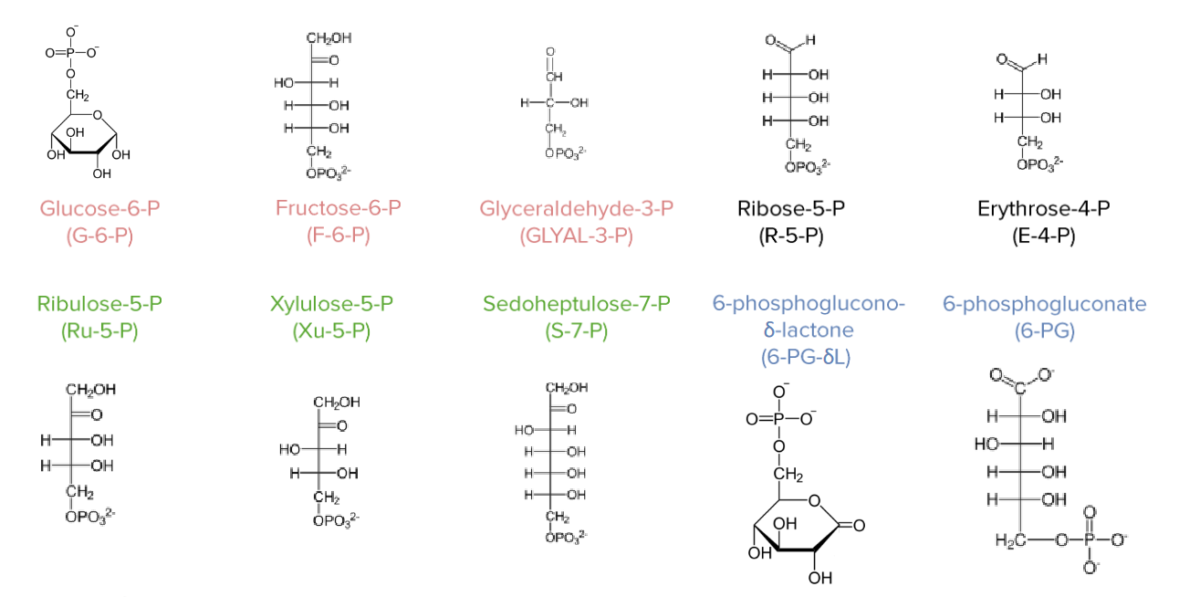
Pentose phosphate pathway intermediates:
Glucose-6-phosphate (G-6-P), fructose-6-phosphate (F-6-P), and glyceraldehyde-3-phosphate (GLYAL-3-P) are intermediates from glycolysis. Ribose-5-phosphate (R-5-P) is used in the synthesis of nucleotides, whereas erythrose-4-phosphate (E-4-P) is used in the synthesis of aromatic amino acids. The bottom row depicts sugars that are either rarely, or never, found outside the pentose phosphate pathway.
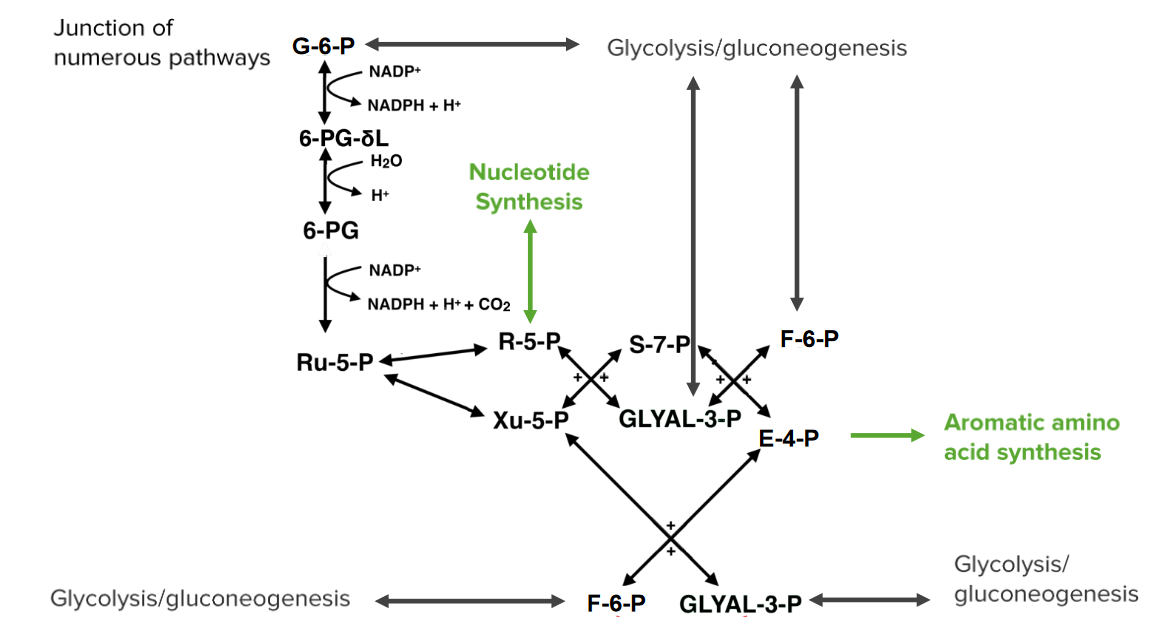
The pentose phosphate pathway acts as a junction point for numerous pathways.
Image showing the multiple entrance and exit points for metabolites, including nucleotide synthesis, aromatic amino acid synthesis, glycolysis, and gluconeogenesis
NADPH: nicotinamide adenine dinucleotide phosphate
P: phosphate
G: glucose
PG: phosphogluconate
L: lactone
Ru: ribulose
R: ribose
Xu: xylulose
S: sedoheptulose
GLYAL: glyceraldehyde
There are 2 major phases that comprise the pentose phosphate Phosphate Inorganic salts of phosphoric acid. Electrolytes pathway:
The oxidative phase is an irreversible, 3-step process.
Initial molecules:
Reactions:
Products:

The oxidative phase converts glucose-6-phosphate (1) into ribulose-5-phosphate (4), forming 2 molecules of NADPH in the process.
NADPH: nicotinamide adenine dinucleotide phosphate
The nonoxidative phase is reversible, utilizing isomerases Isomerases A class of enzymes that catalyze geometric or structural changes within a molecule to form a single product. The reactions do not involve a net change in the concentrations of compounds other than the substrate and the product. Basics of Enzymes to form sugar intermediates that are used in glycolysis Glycolysis Glycolysis is a central metabolic pathway responsible for the breakdown of glucose and plays a vital role in generating free energy for the cell and metabolites for further oxidative degradation. Glucose primarily becomes available in the blood as a result of glycogen breakdown or from its synthesis from noncarbohydrate precursors (gluconeogenesis) and is imported into cells by specific transport proteins. Glycolysis and nucleotide biosynthesis Biosynthesis The biosynthesis of peptides and proteins on ribosomes, directed by messenger RNA, via transfer RNA that is charged with standard proteinogenic amino acids. Virology.
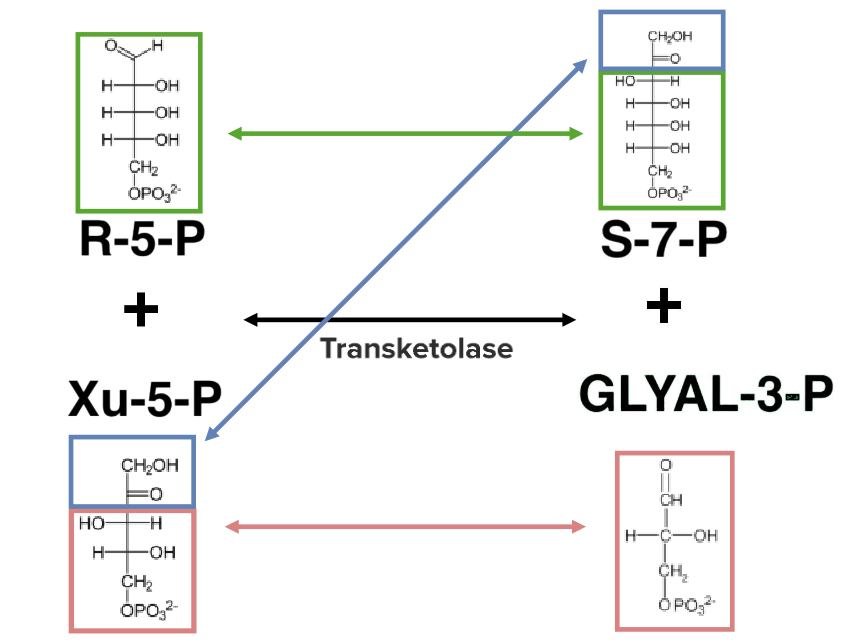
Rearrangement within the nonoxidative phase of the pentose phosphate pathway:
Transketolase transfers 2 carbons from xylulose-5-phosphate (Xu-5-P) to ribose-5-phosphate (R-5-P) to yield sedoheptulose-7-phosphate (S-7-P) and glyceraldehyde-3-phosphate (GLYCAL-3-P).
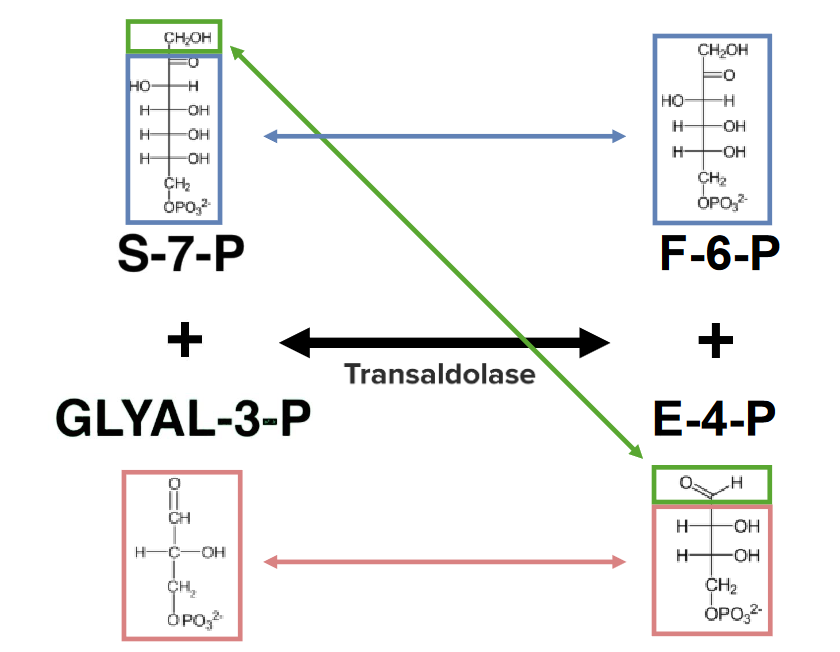
Rearrangement within the nonoxidative phase of the pentose phosphate pathway:
Transaldolase transfers a carbon from sedoheptulose-7-phosphate (S-7-P) to glyceraldehyde-3-phosphate (GLYCAL-3-P) to yield erythrose-4-phosphate (E-4-P) and fructose-6-phopshate (F-6-P).
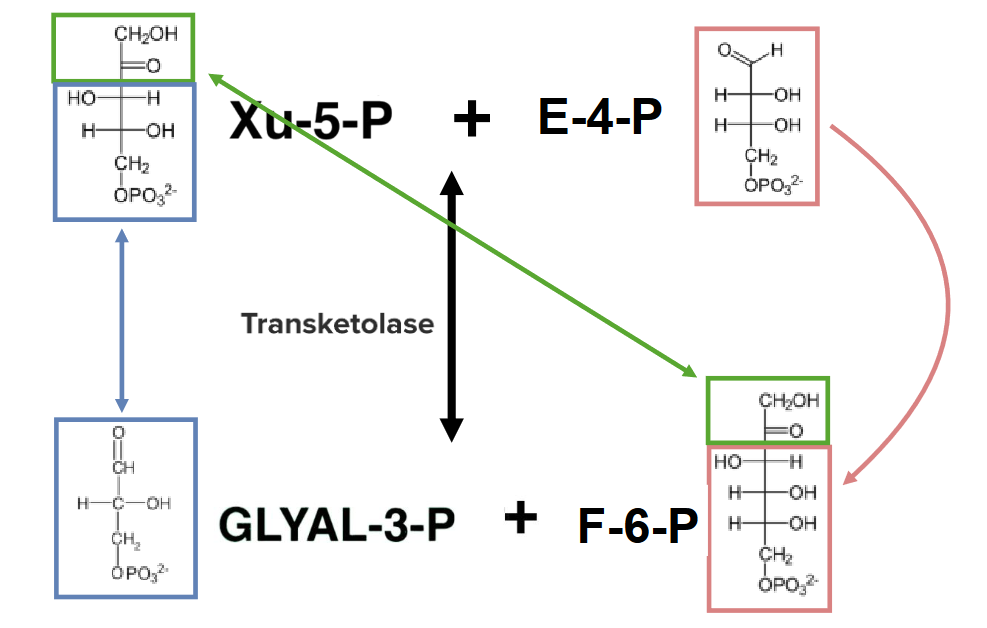
Rearrangement within the nonoxidative phase of the pentose phosphate pathway:
Transketolase transfers 2 carbons from xylulose-5-phosphate (Xu-5-P) to erythrose-4-phosphate (E-4-P) to yield fructose-6-phosphate (F-6-P) and glyceraldehyde-3-phosphate (GLYAL-3-P).